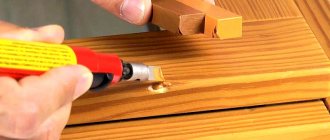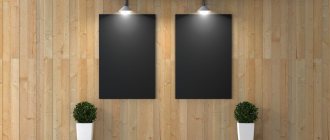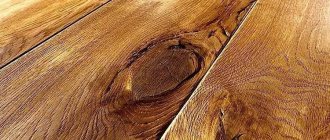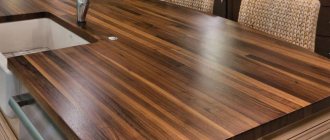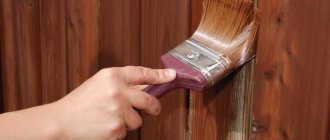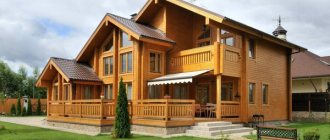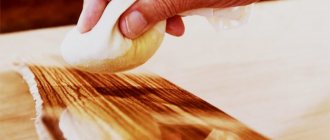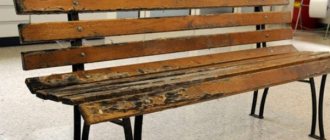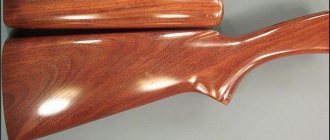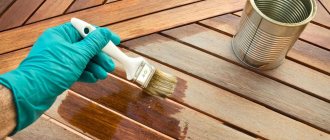Linseed oil and wax for wood treatment is a simple and reliable method that helps ensure wood has a long service life and preserves its properties for a long time. Impregnating wood with linseed oil and wax helps preserve its protective properties. You can prepare a composition for wood processing at home. This is not difficult to do; the materials for manufacturing are also available. On the site you can find a recipe for linseed oil and wood wax. Read the next article on the pages of our magazine.
Wax wood linseed oil
Flaxseed oil is a natural substance obtained by cold or hot pressing of flaxseeds. Pure oil can be used as a stand-alone finishing coating, but in its untreated state it is ineffective due to its low polymerization (drying) ability.
Linseed oil with wax is an effective decorative and protective coating that gives wood high moisture-proof properties
Linseed oil with wax is an effective decorative and protective coating that gives wood high moisture-proof properties and increases its wear resistance. Impregnation adds a silky shine to surfaces and emphasizes the natural qualities of wood. Suitable for processing light and dark wood. A completely natural impregnation is optimal for finishing wooden floors, stairs, doors, furniture and other items subject to intense wear.
Linseed oil and wood wax recipe
It is not difficult to prepare linseed oil and wood wax yourself. The easiest way: add grated beeswax to oil heated in a water bath and bring to a homogeneous consistency. The classic proportion by weight is 1:1. The ratio of wax and linseed oil can be varied, creating compositions of varying degrees of viscosity: from thick mastics to liquid impregnations that penetrate deep into the wood structure.
Types of compositions
Most often, the treatment is carried out not only with one wax, but usually with several formulations, which contain this ingredient.
There are three types of compositions:
- In its soft form, wax can be used to treat the surface frequently and regularly. The coating is obtained with a thin layer, masks scratches and stains, protects against water and insect damage;
- If you need to treat a large surface area, it is better to use liquid wax for this purpose. Can be used simultaneously with dyes of organic and synthetic origin to change the shade of wood;
- If you have a material that needs to be restored from damage and severe breaks, use wax in solid form. It fills all unevenness well and becomes smooth with careful polishing.
The composition of such coating materials contains wax and oil. Usually they take processed products from orange or flax. Wax facilitates the penetration of the composition into the rocks, and oils create protection.
They also take wax of plant origin - carnauba. It is suitable for all surfaces that are subject to constant exposure and wear out quickly. For example, handles or steps of stairs. The composition is prepared only before application, hardens quickly and provides reliable coverage.
Linseed oil with wax for wood processing
Linseed oil with beeswax is a natural impregnation for wood, can be used as an independent decorative coating, ideal for houses and log houses, furniture, doors, wooden flooring made of pine, teak, oak and other types of wood for interior and exterior use. Wood oil is used for both interior and exterior work. Linseed Oil can be tinted perfectly to suit any shade and can serve as a “paint” for wood.
Linseed oil and wax proportions for wood
Wax can be added to flax oil, for this the ratio with wax should be 2 to 8. That is, for two tablespoons of wax, take 8 oils. When adding more wax, the product has increased viscosity.
I grind the wax and melt it in a water bath, then add oil. It must be stirred constantly until it cools completely. This product can be colored using various additives. This composition takes a long time to dry; to speed up this action, it is necessary to add a drier. The wax should be stored in glass containers for about one year.
Beeswax can be mixed with linseed oil in a 1 to 1 ratio. Preparation is carried out in the same way as the previous methods. Sometimes the following recipe is used, two portions of wax, one of oil, and one of turpentine. In this case, the wax is melted in a water bath, then oil is added, stirred, and turpentine is also stirred thoroughly. After hardening, this composition is very dense, but has a pasty appearance and is easy to apply. After treatment, the wood has water-repellent properties.
Linseed oil with wax is a product that provides the best impregnation for the preservation of residential premises, baths and also wood products
Features of the use of waxed products
With all the advantages of the method of treating wood with liquid wax, it should be remembered that wax is a material sensitive to high temperatures. Under their influence he “floats”. Therefore, you need to take into account the features of the room in which future furniture or wood products will be used. Although the heat resistance of some modern industrial samples of liquid wax reaches 100 0C. However, you should not wax your kitchen work surfaces. If you accidentally spill hot food or place heated dishes, traces will remain. Which can only be removed by repeated waxing.
Wax is not compatible with products containing alcohol. When choosing a care product for waxed furniture, you should carefully read the composition and instructions. In general, it is enough to simply wipe it with a dry soft cloth, and to remove dirt or remove fingerprints from time to time use special cleaners with the obligatory mark “for waxed surfaces.”
Subject to application technology and proper care, coating wood products with liquid wax will ensure a long service life and a noble appearance.
Impregnation of wood with linseed oil and wax
Flaxseed oil with wax is a product that provides the best impregnation for the preservation of residential premises, baths, and also wood products. Linseed oil is one of the most famous finishing materials for wood. Despite the capabilities of other materials, in almost all respects the best linseed oil continues to be highly rated for its environmental friendliness, strength characteristics, ability to highlight the natural structure of wood and low price.
Linseed oil with wax is an effective decorative coating that gives wood high moisture-proof qualities and increases its strength characteristics. Impregnation adds a special shine to the surfaces and highlights the natural advantages of wooden surfaces. Suitable for finishing valuable species.
It is indisputable that the wooden coating will become more protected by oil wax. It is made on the basis of linseed oils. In addition, after impregnation of the wood, the color palette of the surface is preserved and does not change in any way, and due to the fact that bean wax is included in the oil wax, the wooden base appears shiny. Wax based on linseed oil can be used to impregnate light-colored wood substrates, also made from expensive wood species.
Properties of linseed oil with wax for impregnating wood:
- linseed oil with wax dries 4 hours after application; (and for linseed oil to dry completely it will take at least 4 months);
- Oil with wax has excellent water-repellent characteristics;
- oil with wax has a silky shine that cannot be seen when using ordinary linseed oil;
- The usual oil and wax consumption is 130 g/sq. m
What you need for waxing
In order to apply wax correctly, you will need a number of tools. You need to prepare them before work:
- Directly wax;
- Sandpaper for polishing the surface;
- Solvent or cleaner;
- Sharp knife;
- Brushes for applying the composition;
- Brush;
- Cloth.
After everything is ready, you can proceed directly to the work itself.
Linseed oil and wood wax
Flaxseed oil with beeswax is used not only in the cosmetology and pharmaceutical industries, it is used in woodworking to improve the technical and operational characteristics of the material. Oil-wax for wood does not create a fragile film on the surface of the boards, as happens when using varnish, but is absorbed into the structure of the fibers, as a result of which the wood becomes harder and more durable.
How to apply linseed oil with wax for wood treatment
Oil containing wax is applied only to cleaned wood. The old surface must be cleaned to the ground, removing any traces of paints from it. In order to remove hairiness, the surface is sanded with an emery wheel mounted on an eccentric machine or manually with sandpaper.
Oil containing wax is applied only to cleaned wood.
In order for the particles of the composition to better saturate the base, it is recommended to slightly warm it up. Painting is carried out with a paint brush, the bristles of which, moving in the direction of the fibers, penetrate into the smallest grooves between them.
The internal surfaces are covered with 2 layers, between which drying occurs. The layer needs to dry for at least 2 hours. For external surfaces it is necessary to do 3 layers. After triple impregnation, subsequent treatment will be required no earlier than after 15 years.
After waiting 10 minutes after working with the brush, remove the remaining oil with a napkin and wipe the surface dry with a rag. This precaution will help to avoid influxes and divorces. Painted wood can only be exposed to loads after 3 days. If the treatment took place in an unventilated area, the period for putting the impregnated surface into operation increases to 5 days.
Sources:
- https://woodschool.ru/otdelka-dereva-lnyanym-maslom.html
- https://xn--b1amnebsh.xn——8kcamlbcr2cq0ahenz4r.xn--p1ai/lnyanoe-maslo-s-voskom-dlya-dereva.html
- https://kaknadostroit.ru/stroimaterialy/derevo/maslo-vosk-dlya-dereva-svoimi-rukami
- https://lesobirzha.ru/katalog/kraska/filter/produkt-maslovosk/
Using mixtures of different consistencies
The choice of wax mixture based on consistency depends on the texture of the wood, the depth of cracks on the surface and their number. Minor damage is taken into account.
- A liquid composition or oil wax is used for application to surfaces with a large number of microdamages, with a small penetration depth. Oil wax contains a lot of natural solvent, which makes it look like regular varnish.
- A solid wax mass is applied to the surface with deep cracks if chips have appeared.
- Due to its variety of colors, soft wax (reminiscent of mastic) is matched to the interior so that the wooden item looks in tandem with textile elements.
Manufacturers offer the wax composition in jars of different capacities. Knowing its consumption, the material is purchased once for the entire wooden structure. A small area of wood is treated with a wax pencil.
Why is this necessary?
The paintwork of a car has a limited service life. Over time, the paint fades and damage forms on the surface. Car body wax is used to remove:
- scratches;
- microcracks;
- chips.
The substance fills defects in the car coating, resulting in the formation of an even, smooth surface. The hydrophobic protective film formed after the mixture hardens adds brightness and shine. Additionally, coating the car with wax provides the body with protective properties. The impact on the paint layer of the car is minimized:
- ultraviolet;
- chemical substances;
- dust and dirt;
- detergents.
It is necessary to cover the body with liquid car wax at least twice. This condition results in the presence of a complete protective film on the surface of the vehicle.
Varieties
There are several ways to classify material.
Depending on the type of wax:
On hard wax
This category includes products on Caranuba and Candelilla wax. They add shine to the surface and have water- and dirt-repellent properties. Protects the base shade from fading. The materials are safe to use. Suitable for processing any surfaces.
On beeswax
This product acts in the same way as previous materials, but it has a lower melting point, so it does not increase the fire safety of wooden furniture.
Depending on the shade, the following products are distinguished:
- Colorless. There are no dyes in the composition of such materials. Thanks to this, the furniture retains its original shade.
- Colored. Materials containing dyes. They tint the surface, giving it the desired shade.
Depending on the type of wood, products are allocated for oak, pine, etc.
Both colorless and colored products have the same properties. The only difference is that the latter tint the furniture, while the former do not.
